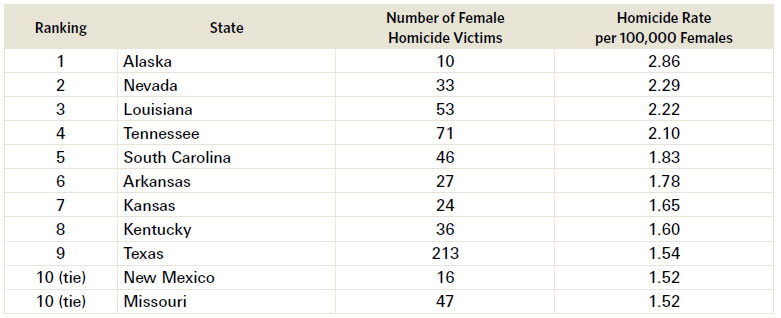For release: Thursday, September 21, 2017
Annual Study Released in Advance of Domestic Violence Awareness Month in October Ranks States by Rate of Women Killed by Men
Washington, DC — More than 1,600 women were murdered by men in 2015 and the most common weapon used was a gun, according to the new Violence Policy Center (VPC) study When Men Murder Women: An Analysis of 2015 Homicide Data.
This annual report is released in advance of Domestic Violence Awareness Month in October. The study uses 2015 data, the most recent year for which information is available. The study covers homicides involving one female murder victim and one male offender, and uses data from the Federal Bureau of Investigation’s Supplementary Homicide Report.
The study found that nationwide, 93 percent of women killed by men were murdered by someone they knew and that the most common weapon used was a gun.
“Women killed by men are most often killed by someone they know and more than half were killed by an intimate partner,” says Legislative Director Kristen Rand. “Much more must be done to identify and implement strategies to prevent these tragedies. More resources are needed at the federal, state, and local levels to help keep women safe.”
The Violence Policy Center has published When Men Murder Women annually for 20 years. During that period, nationwide the rate of women murdered by men in single victim/single offender incidents has dropped 29 percent — from 1.57 per 100,000 in 1996 to 1.12 per 100,000 in 2015.
Below is a list of the states with the 10 highest rates of females murdered by males in single victim/single offender incidents in 2015:

For each of these states, the study offers a detailed summary including: the number of victims by age group and race; the most common weapons used; the victim to offender relationships; and the circumstances of the homicides.
Nationwide statistics from the study include the following.
Nationwide, 1,686 females were murdered by males in single victim/single offender incidents in 2015, at a rate of 1.12 per 100,000. Of the 1,686 female homicide victims, 1,110 were white, 476 were black, 48 were Asian or Pacific Islander, 28 were American Indian or Alaskan Native, and in 24 cases the race of the victim was not identified.
Nine out of 10 victims knew their offenders. Of the victims who knew their offenders, 64 percent were wives or other intimate acquaintances of their killers. Fourteen times as many females were murdered by a male they knew than were killed by male strangers.
Black women are disproportionately impacted by lethal domestic violence. In 2015, black females were murdered by men at a rate of 2.43 per 100,000, more than twice the rate of 0.96 per 100,000 for white women murdered by men.
Firearms — especially handguns — were the weapons most commonly used by males to murder females in 2015. Nationwide, for homicides in which the weapon used could be identified, 55 percent of female victims were shot and killed with a gun. Of the homicides committed with guns, 69 percent were killed with handguns.
The overwhelming majority of these homicides were not related to any other felony crime, such as rape or robbery. Nationwide, for homicides in which the circumstances could be identified, 84 percent of the homicides were not related to the commission of another felony. Most often, females were killed by males in the course of an argument between the victim and the offender.
The study calculates the rate of women murdered by men by dividing the total number of females murdered by males in single victim/single offender incidents by the total female population and multiplying the result by 100,000. This is the standard and accepted method of comparing fatal levels of gun violence.
The study urges state legislators to adopt laws that enhance enforcement of federal legislation and ensure that guns are surrendered by or removed from the presence of abusers.
To view the full report, please visit http://vpc.org/studies/wmmw2017.pdf.
The Violence Policy Center is a national educational organization working to stop gun death and injury. Follow the VPC on Twitter, Facebook, and YouTube.






